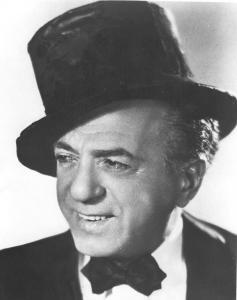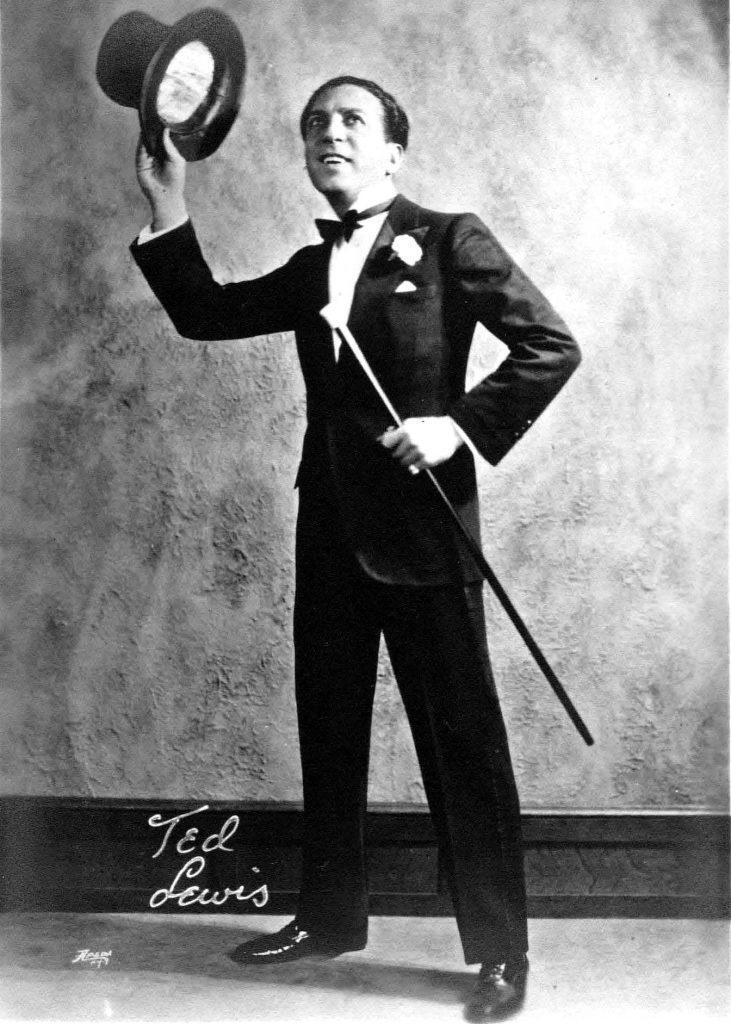The Man from Circleville
The man the public came to know as Ted Lewis was born Theodore Leopold Friedman on June 6, 1890 in Circleville, Ohio. Circleville back then was a community of 6,500 residents, 30 miles south of Columbus. It derived its name from the circular portion of large, ancient earthworks that were a remnant of the Native American Hopewell culture. The town was built on top of these remains, with the streets laid out within a circle 1,100 feet in diameter, and featuring an octagonal courthouse at the very center.
Theodore’s parents owned Friedman’s Bazaar, an emporium that sold the latest in fashions to the womenfolk of Pickaway Country. When a German music teacher, Oscar Armeringer, came to town and formed the Circleville Boys’ Band, Ted became a member. Armeringer taught him to play the piccolo, and when in high school, the aspiring musician earned enough money mowing lawns to buy a B-flat clarinet. Ted eventually added the C-melody saxophone and trumpet to the list of instruments he could play.
His turn to “innovative syncopation”, was inspired by James “Cricket” Smith, a local Black barber who had organized a barbershop orchestra. When the young clarinetist decided to “jazz-up” his solo at a Boys’ Band’s concert on their rendition of Poet and Peasant Overture, he was told by the stern Germanic conductor that he should take his musical services elsewhere. By his early teens, he would play the clarinet to attract crowds for the traveling medicine shows that came to town promoting some miracle elixir purported to cure all ailments known to mankind. His first professional job as a vocalist found him singing songs between movies at the Circleville Nickelodeon for four dollars a week.
Show Business
His parents enrolled him in a business college in Columbus, but his focus was on music and not academic studies. While working in a music store, he met Gus Sun, a former circus juggler who operated a booking agency for as many as 275 small-time vaudeville theaters, mostly in the Midwest. (Early in their careers, the Marx Brothers, W.C. Field, Mae West, and Bob Hope worked for Gus Sun, who was said to be so cheap that he sent his telegrams collect to clients notifying them about bookings.)
By 1909, Ted and his older brother Edgar formed a musical act they called “The Warden and the Jailbird Coon” and went on the Gus Sun vaudeville circuit. When Ed tired of show business and the travel, Ted moved to New York City and got a job playing clarinet and saxophone at the El Dorado Café. Along the way, he met Jack Lewis, and they went on the road with an act called “Lewis & Friedman.” When performing in the Carolinas, the billing on the theater marquee advertised “Lewis & Lewis.” The theater manager explained he changed the name to fit on the marquee, and Ted Friedman was thereafter known to the world as Ted Lewis, although he never legally changed his name.
A disastrous tour of Canada left the duo broke and stranded, and Ted returned to Circleville before again heading to New York in 1915 where he put together a five-piece ensemble called the Ted Lewis Nut Band. Several musicians had been part of a circus band, so it was not unusual for them to dress in clown suits when performing.
Notwithstanding, the band had a successful engagement at the College Cabaret at Coney Island and later was booked for a season with dancers Bessie Clayton and Joan Sawyer at Cafe Au Caprice.
Jass
Earl Fuller was a pioneering bandleader who helped to initiate the popularity of jazz in New York City just prior to America’s entry into World War I. He was the musical director for Rector’s Restaurant, known as “the celebrated lobster place” at Broadway and 44th Street that fed 1,000 people a day and where dinner cost two dollars. Rector’s management instructed Fuller to organize a “jass” band to compete with the Original Dixieland Jazz Band that had taken the town by storm playing for dancing at Reisenweber’s Café on Columbus Circle. In April of 1917, Ted was hired to front Earl Fuller’s Famous Jazz Band and play clarinet.
During an intermission at Rector’s, the battered old top hat was acquired in a dice game with a cab driver, a former prizefighter called “Mississippi.” A few nights later at the end of a dance set, Ted tipped the hat and asked, “Is everybody happy?” Getting a positive response, that became his famous trademark phrase, along with his clarinet and cane, throughout the remainder of his career.
Fuller’s Famous Jazz Band was a big success, but by mid-1919, Ted was getting lucrative offers to play elsewhere. When their contract came up, the band members opted not to renew and left Rector’s minus Earl Fuller. It wasn’t long before Ted Lewis was on stage at the Greenwich Village Follies, Ziegfeld Midnight Frolic, and Keith’s Palace Theatre, the first show business celebrity to headline three Broadway nightspots at the same time.
Recordings
He signed to record with Columbia Records and later with Mercury, Decca, and RKO Unique. His 1926 Columbia recording of “Tiger Rag” sold more than five million copies which were produced with a customized silver label featuring his name and silhouette in his top hat. His 1932 recording of “In a Shanty in Old Shanty Town” was #1 on the charts for 10 weeks.
While theatrical lore attributes Ted’s famed “Me and My Shadow” routine to a young usher, the more accurate version has Eddie Chester, a member of Lewis’ company, watching from the wings as Ted performed the song and deciding to follow him on stage and mimic his movements. The audience loved it, and Ted kept the routine in his act. Lewis would work with four other shadows (all African-Americans, the best-known of whom was Charles “Snowball” Whittier) during his career, making him the first prominent white entertainer to showcase Black performers.
Talent Scout
An indication of Lewis’ ability to recognized up-and-coming talent is obvious from the number of famous musicians who played or recorded with him early in their careers. Between 1924 and 1931, the list included Benny Goodman, Frank Teschemacher, Jimmy Dorsey, Jack Teagarden, Fats Waller, George Brunies, Don Murray, Muggsy Spanier, and vocalists Sophie Tucker and Ruth Etting.
Marriage
In 1915, Ted met ballerina Adah Becker in Rochester, New York, and six weeks later they were married in three separate ceremonies on the same day. The first was before a Justice of the Peace, next by a Rabbi, and finally on stage that evening. They lived in a 15-room apartment overlooking New York’s Central Park and were married for 56 years. Adah gave up her dancing career to become Ted’s secretary, business manager and helpmate through his long career.
Late Career
Lewis kept his band together through the 1950s, and he personally continued to make appearances on television and in Las Vegas into the 1960s. True to his vaudeville beginnings, he created a visual as well as a musical set. His physical presence with props like his top hat combined with bits of visual humor and dancing were as important to him as his music. Showmanship was what sustained his career for 60 years.
Ted Lewis is described as “a combination of musician, satirist, dancer, singer, songwriter, minstrel, and troubadour.” He called himself “the high-hatted tragedian of song,” and when singing sentimental, hard-luck songs, he would improvise chatter that gave the effect of “speaking” a tune – “When ma’ baby… when ma’ baby smiles at me… gee, what a wonderful, wonderful light that comes to her eyes… look at that light, folks.”
Ted Lewis died in his sleep on August 25, 1971 at the age of 81. Following a Jewish funeral service in New York City, his body was brought to Circleville where thousands viewed his coffin. Rabbi Jerome Folkman officiated, telling the congregation: “The song has ended, but the memory lingers on.” Burial took place in the local Forest Cemetery where Ted’s stone in the family plot has his hat and cane incised upon it. Adah Becker Lewis died on May 31, 1981 and is buried next to her husband.
Related: Ted Lewis: Circleville Honors Its Favorite Son
Also see: Ted Lewis (1890-1971) on the Red Hot Jazz Archive
Lew Shaw started writing about music as the publicist for the famous Berkshire Music Barn in the 1960s. He joined the West Coast Rag in 1989 and has been a guiding light to this paper through the two name changes since then as we grew to become The Syncopated Times. 47 of his profiles of today's top musicians are collected in Jazz Beat: Notes on Classic Jazz.Volume two, Jazz Beat Encore: More Notes on Classic Jazz contains 43 more! Lew taps his extensive network of connections and friends throughout the traditional jazz world to bring us his Jazz Jottings column every month.
























